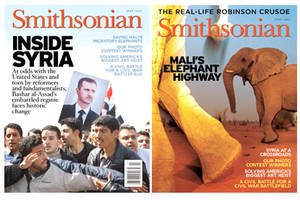Editorial: When Readers see Double on the Newsstand
Though a split cover may not always translate into increased newsstand pick-up, there are many valid reasons to try it—to test which subjects play better geographically; to illustrate an editorial concept; or to generate a publicity buzz at minimal cost.
When in July 2005, Smithsonian featured its first split cover (shown here) in 35-years, the goal was equally to boost paltry single-copy sales and to convey to prospective readers “this is not your grandmother’s Smithsonian.”
 The newsstand version featured “Inside Syria,” a story on the country’s mounting pressure to conform to international ideologies. The subscriber copy featured the less topical “Mali’s Elephant Highway.”
The newsstand version featured “Inside Syria,” a story on the country’s mounting pressure to conform to international ideologies. The subscriber copy featured the less topical “Mali’s Elephant Highway.”Split covers are increasing popular in the West. Years ago, Newsweek’s cover on “The New Middle Age” alternated between a man and a woman exclaiming, “Oh. God . . . I'm really turning 50!”. However, nowadays, the differences between covers are not so easily discernable, as shown by these examples.
TRIVIA: When the cover splits to reveal an ad…
...it is a not split cover. Some of us use the term spilt cover to refer to French Gate or bran door advertisements, where the reader sees the cover image but can open the left and right ‘barn-door’ flaps to expose a second cover (usually a paid ad) underneath!
Labels: Editorial



1 Comments:
Could not find a suitable section so I written here, how to become a moderator for your forum, that need for this?
Post a Comment
<< Home